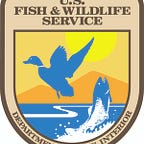From Chasing Frogs to Restoring Habitat: Grant Specialist Heather Hollis Helps Partners Practice Conservation
By Lev Levy, public affairs officer, Pacific Region of the U.S. Fish and Wildlife Service.
Heather Hollis, a grant specialist with the Wildlife and Sport Fish Restoration program, took time to answer some questions about her job. What Heather does is critical in supporting the conservation work of our state partners. Read on to learn more about Heather and her work.
- Hey Heather! Tell us about yourself.
I was born in Port Colborne, Ontario, Canada, and immigrated to the U.S. with my parents when I was a small child. My memories of Ontario include the farm where my dad was born. It was pure heaven running through the barn and chasing frogs in the creek. It was much different in Torrance, California, where I grew up with not as much open space and the channelized Los Angeles River.
2. What did you study? How did you get involved in public service?
I stayed in southern California for college and earned bachelor’s and master’s degrees in biology from Cal State Long Beach. I was fortunate enough to learn about a seasonal Forest Service position on the Shasta-Trinity National Forest the summer before I graduated with my master’s degree. Little did I know that the job would launch a 35-year career in natural resources management. Back in Long Beach, I finished my degree and graduated the same time as Kevin Foerster, our recently retired Refuge Chief in the Pacific Region. He told me about a term job at the Service’s (then) Laguna Niguel Ecological Services field office. I worked there for a year-and-a-half and then got a permanent job on the Sierra National Forest, Kings River Ranger District. I stayed there for three years, and then went to a Forest Service job in Albuquerque, New Mexico. I was there for seven years before coming to Portland for a job in Ecological Services. In 2000, I was tasked with completing a land acquisition grant, as part of a Habitat Conservation Plan, funded under section 6 of the Endangered Species Act. From that first grant, I knew I wanted to work with our state grantee partners and the Wildlife and Sport Fish Restoration Program. The program was known as Federal Aid back then. I managed the Section 6 program for over a decade before transferring.
3. Can you tell us a little bit about your job?
I manage grants under the Federal Aid in Wildlife Restoration Act of 1937, otherwise known as the Pittman-Robertson Act, for the mainland states of Idaho, Oregon, and Washington. The only exception is that the hunter education grants are managed by someone else. This program is funded through excise taxes on firearms and ammunition, as well as archery equipment. Funds go out to the state fish and wildlife agencies under a formula. Project activities include acquisition and improvement of wildlife habitat, wildlife management, wildlife research, surveys and inventories of wildlife species, acquisition and development of access facilities for agency and public use, wildlife health surveillance, and hunter education programs.
4. What’s your favorite thing about working for the Service?
There are two things I have to say make my job so rewarding. First is the Wildlife and Sport Fish Restoration team, and second is the partnerships with our state grantees.
5. What advice do you have for someone interested in a career in conservation, public service, and/or with the Service?
Study something that interests you and get an education! There are lots of opportunities with the Service in fish and wildlife management and lots of other jobs as well. I would say explore lots of options, do details, and move around to different areas of the country. There is so much beauty to explore, so go have fun.
If you’re interested in a career in conservation, you can check out the following websites:
Directorate Resource Assistant Fellowship Program (DFP Program)
